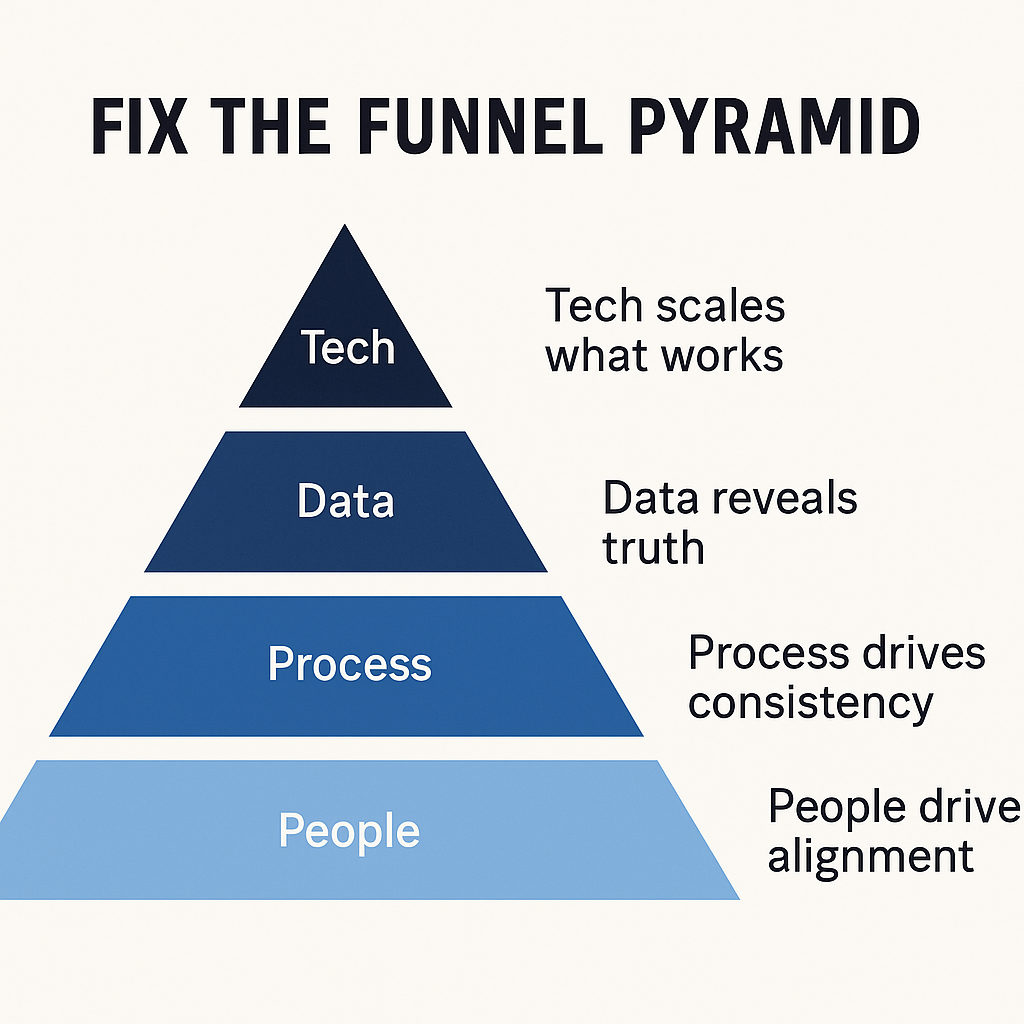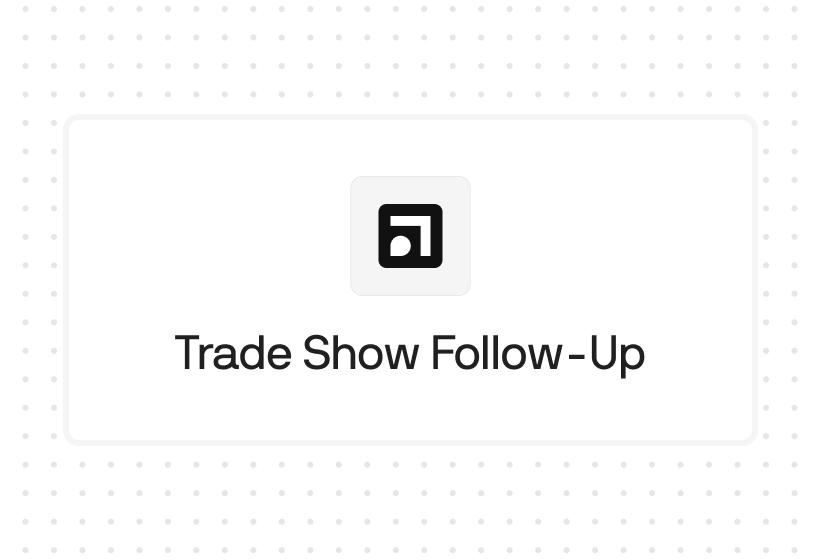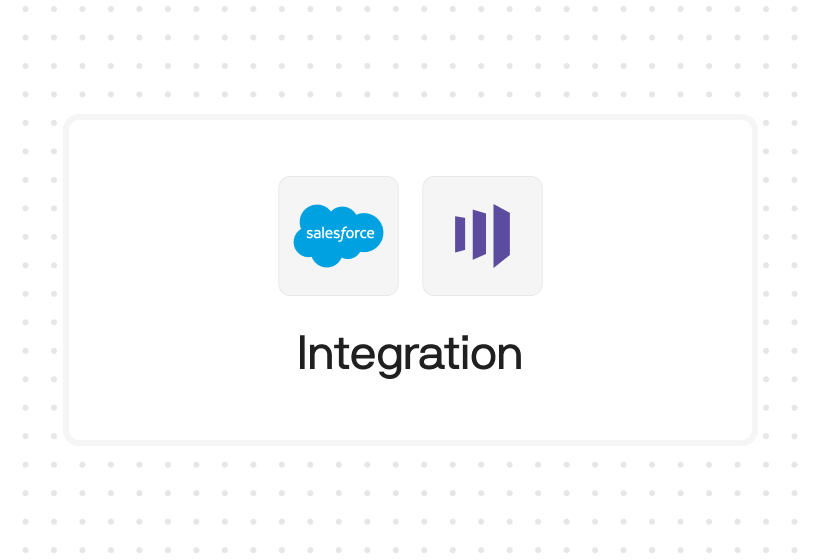Try Default

See how revenue teams automate revenue operations with Default.

Key Takeaways
Key takeaways
- Funnel leaks often hide in plain sight — in CRM gaps, slow follow-up, poor handoffs, and misaligned GTM processes
- Diagnosing leakage means going beyond top-of-funnel metrics to stage-level visibility, response time, and deal velocity
- Fixing leaks requires stacked solutions across people, process, data, and tech — not isolated tactics
- Tools like Default help RevOps teams audit faster, surface issues earlier, and fix what’s breaking conversion behind the scenes
You’re getting leads. Your team is putting in the work. But something’s off—your sales numbers aren’t matching the effort.
That’s the silent pain of a leaky funnel.
It doesn’t blow up your pipeline overnight. No, it chips away at it slowly… Bad handoffs, bloated CRM fields, unclear next steps. And most teams don’t notice until it’s already hurting growth.
This isn’t about fixing one tool or optimizing one stage. It’s about seeing the bigger picture: where your funnel is quietly losing momentum—and what to do about it.
We’ll walk you through how to find the leaks, fix the gaps, and build a sales funnel that doesn’t waste your best opportunities.
Understanding where funnels leak revenue
Funnels don’t fail at just one stage, they weaken across the entire buyer journey. The problem is, most teams only look at top-line conversion rates. That’s not enough.
Leakage happens when high-intent prospects drop off for reasons you should be able to control: slow follow-up, unclear handoffs, messy CRM data, or misaligned messaging. Left unchecked, these small fractures compound into big revenue gaps.
To fix it, you need visibility at every stage—from lead capture to closed-won—and a process that flags friction before it becomes fallout.
Causes of leaky sales funnels
1. Poor lead qualification
When qualification criteria are too loose, reps waste time chasing low-fit accounts. The result? Low SQL conversion rates, frustrated sales teams, and bloated forecasts that never materialize.
This often stems from static ICP definitions or a lack of feedback from sales to marketing on lead quality.
Pro tip: Revisit ICP definitions quarterly, using win/loss data to adjust your qualification filters and lead scoring logic.
2. Inconsistent or delayed follow-up
Speed still wins deals. When inbound leads aren’t followed up on quickly, qualification rates drop and pipeline velocity suffers.
If you respond within 30 minutes, you’re 21X more likely to qualify the lead than if you wait just half an hour. Respond within 5 minutes, and you’re 100X more likely to reach them. This isn’t a sales productivity issue—it’s a conversion efficiency issue.
The problem? Most teams still depend on fragmented tools or manual handoffs, creating delays that quietly reduce funnel performance
Default tracks lead response time across reps and flags SLA breaches—so GTM teams can maintain speed without relying on rep memory or workarounds.
3. Handoff breakdowns between teams
When a lead moves from one team to another—marketing to sales, sales to onboarding, onboarding to CS—there’s often no structured process for what gets shared. Context gets lost, and the buyer experience suffers.
That leads to repetitive conversations, generic outreach, and delayed deal progression. Even small drops in momentum compound quickly.
4. Dirty or incomplete CRM data
You can’t optimize what you can’t trust. Inaccurate, incomplete, or duplicate data in your CRM makes it impossible to trigger the right automations, personalize outreach, or measure funnel health accurately.
Bad data also leads to poor segmentation, broken nurture flows, and reporting that masks the real source of leakage.
Platforms like Default help surface missing or inconsistent CRM fields—like unassigned owners or lead sources—before they break your funnel logic or block automation.
5. Messaging misalignment across the funnel
When the story changes from ad to demo to onboarding, your credibility takes a hit. If the promise made by marketing isn’t reinforced by sales, or if onboarding resets expectations, prospects start to disengage.
This disconnect often comes from siloed teams working off different assumptions about value, pain points, or buyer journey stages.
6. No defined next steps at critical moments
Every stage of the funnel should lead the prospect forward. But when there's no clear CTA, timeline, or deliverable after a meeting or email, deals lose momentum. The result: ghosting, delays, or indefinite “checking in” loops from reps.
This usually points to a sales process with too much variability—where next steps depend more on the rep than the playbook.
7. Over-engineered workflows
Inbound automations are meant to scale your process, not complicate it. But when sequences become too rigid or complex, they start to introduce friction: prospects receive irrelevant messages, fall into overlapping cadences, or miss key interactions altogether.
You’ll see these self-inflicted leaks in teams that prioritize tools over process—adding complexity without addressing the root friction.
8. Lack of conversion-stage visibility
Most teams can rattle off MQL-to-SQL rates. Fewer can tell you where deals actually break down—and why. Without stage-level visibility, you’re reacting to symptoms, not solving the real problem.
This blind spot blocks effective coaching, forecasting, and process refinement.
9. Weak feedback loops across the funnel
Without strong feedback loops across teams, the same issues keep surfacing. Sales fields poor-fit leads, marketing misfires on messaging, and CS inherits avoidable churn.
Strong RevOps orgs close these loops intentionally—via shared dashboards, post-mortems, and a culture of upstream accountability.
Pro tip: Build a monthly RevOps sync focused solely on identifying friction and translating it into process fixes.
Funnel leak causes vs. impact
Solutions to fix a sales funnel that is leaking customers
Fixing funnel leaks isn’t about slapping on tools. It’s about stacking your foundation—starting with people and process, then reinforcing it with clean data and scalable tech. The most resilient funnels are built in that order. Here’s how to apply it.
1. Tighten lead qualification with sales-led scoring
Pillar: People + Data
Marketing can generate volume, but it’s sales that knows which leads actually convert. Instead of relying solely on marketing’s MQL logic, introduce sales-led scoring that factors in deal-fit, buyer intent, and past conversion trends.
Pro tip: Build a shared scoring model that maps to closed-won patterns—then iterate monthly based on win/loss feedback.
2. Align messaging with a single value narrative across funnel
Pillar: People + Process
Every stage—from ad to close—should reinforce one clear value story. That doesn’t mean repeating the same lines, but adapting the same message to each buyer conversation. No mixed signals, no surprises.
Pro tip: Build a shared message map that outlines key value props by persona and stage—updated quarterly by RevOps.
3. Build structured handoff protocols between teams
Pillar: Process
Whether it’s MQL to SDR, AE to onboarding, or CS to expansion, every handoff should come with clear context: key details, goals, risks, and next-step ownership. Standardization here reduces friction and keeps buyers engaged.
Pro tip: Use a one-click Handoff Doc template that auto-fills key CRM fields—shared between teams in your workspace.
4. Make next steps visible and non-optional at every sales stage
Pillar: Process
A deal without a next step isn’t a deal—it’s a delay. Train reps to document next actions with owners and due dates after every call or interaction. Pipeline reviews should spotlight deals without clear momentum.
Pro tip: Add a ‘Next Step Confirmed’ field to each stage in your CRM—and make it required to progress.
5. Set and enforce follow-up SLAs with live dashboards
Pillar: Process + Tech
Follow-up timing should be visible and accountable. Live dashboards showing response times by rep or team create healthy pressure—and prevent warm leads from cooling off in the dark.
Default tracks lead response time across reps and alerts teams when follow-up SLAs are missed—so no high-intent lead sits idle.
6. Clean CRM data with field validation and enrichment tools
Pillar: Data
Manual cleanup doesn’t scale. Mature teams set validation rules (e.g. required lead source or persona tags) and use enrichment tools to auto-populate firmographics. This keeps funnel-critical fields usable without admin drag.
Use Default to flag incomplete fields like lead source or lifecycle stage, auto-assign owners, and enrich records in real time.
7. Instrument funnel drop-offs with stage-level analytics
Pillar: Data + Tech
Don’t just track funnel progression—track drop-off between stages. Knowing that 42% of deals stall after demo tells you where to coach, not just what to track. Funnel analytics tools (or custom CRM reports) can surface this quickly.
Pro tip: Set up conversion rate benchmarks by stage. Any week you drop 10%+ in a stage triggers a review.
8. Audit and simplify nurture workflows quarterly
Pillar: Tech + Process
If your nurture sequences or automation rules feel like a Rube Goldberg machine, they probably are. Over-complexity creates noise, not scale. Review workflows quarterly to cut bloat, fix logic errors, and tighten triggers.
Pro tip: Use a visual workflow map to surface overlaps—then sunset underperforming sequences with low engagement.
9. Operationalize feedback loops with shared RevOps dashboards
Pillar: People + Process
Instead of anecdotal feedback in Slack, build a shared space where teams surface repeat issues: bad-fit leads, missed SLAs, churn drivers. Dashboards make the feedback visible—and harder to ignore.
Pro tip: Use call tags, NPS verbatims, and lead reasons lost as inputs for monthly trend reviews across GTM.
Build it in the right order
People drive alignment.
Process drives consistency.
Data reveals truth.
Tech scales what works.
Stack them right, and your funnel stops leaking.

Real-world examples of sales funnel leakage
You can spot funnel leaks in dashboards, but it’s the stories behind the numbers that really drive action. Here are two real-world cases where companies uncovered high-impact funnel issues, made targeted changes, and saw measurable results.
GoCardless: One word, 139% more conversions
GoCardless realized their funnel was leaking at the very first step: the demo request CTA. Prospects were stalling, and engagement on the landing page was lower than expected. After testing the language, they swapped “Request a demo” for “Watch a demo”—a subtle shift that removed friction and made the next step feel lower-commitment.
The result? A 139% increase in demo video views—and a significantly healthier pipeline.
Takeaway: Small copy changes can fix big leaks, especially at high-traffic conversion points. If a CTA feels like a barrier, your funnel’s already leaking.
Superfi: A 41% lift from better funnel visibility
Superfi, a UK-based electronics retailer, wasn’t lacking traffic—but too many users were dropping off mid-funnel. After implementing funnel tracking and split-testing tools, they uncovered a key issue: their product pages weren’t clearly guiding buyers to the next step.
By optimizing layout, simplifying copy, and adjusting their calls to action, they achieved a 41% increase in funnel conversion rate.
Takeaway: Funnel drop-offs often stem from unclear UX and next-step ambiguity. Without instrumentation, you’re guessing where the friction is.
Pro tip: The fastest way to spot silent leaks is with a funnel audit—combine clickstream analytics, CRM stage conversion rates, and qualitative feedback to build a complete picture.
With tools like Default, RevOps leaders can spot these patterns earlier—before they start bleeding into forecasts and pipeline health.
The cost of a leaky sales funnel
Funnel leakage isn’t just a conversion problem. It quietly inflates your pipeline, masks inefficiencies, and misleads your team on what’s actually working. Most orgs don’t see the cost clearly—until it’s already baked into revenue misses, bloated CAC, and forecasting chaos.
Here’s what leakage really costs RevOps teams:
1. Inflated pipeline, unreliable forecasts
When leaks go unchecked, pipeline metrics start lying. You’ll see volume at the top—but much of it isn’t real. Deals stall mid-funnel. Close rates dip. And suddenly the forecast is off by 20–30%, eroding trust across GTM teams.
RevOps lens: Without clear deal progression visibility, your team can’t distinguish between healthy pipeline and padded volume. That makes coaching harder and strategy reactive.
What to watch for: High lead-to-opportunity ratios, low opportunity-to-close rates, and repeated surprises in forecast vs. actual.
2. Rising CAC with no clear cause
Your demand engine’s firing—but CAC keeps climbing. Why? Because poor lead quality, slow follow-up, or broken nurture flows mean more leads are wasted. You’re paying for the same volume, but fewer make it to closed-won.
This is where funnel waste becomes financial. Leakage inflates acquisition costs, distorts ROI models, and makes growth look less efficient than it is.
What to watch for: Blended CAC rising even as CPL stays flat, or decreasing LTV:CAC ratio despite stable product metrics.
3. Siloed teams and GTM misalignment
When deals fall through the cracks, the finger-pointing starts. Marketing blames sales for sluggish follow-ups. Sales blames marketing for low-quality leads. CS inherits churn risk from unmet expectations. The root cause—process gaps—gets overlooked.
RevOps lens: Funnel leakage isn’t just lost revenue—it’s a coordination failure. If your GTM teams don’t share a full-funnel view, alignment breaks fast.
What to watch for: Low MQL-to-SQL conversion, no clear handoff rules, and inconsistent CRM notes or ownership fields.
4. Misplaced priorities and wasted cycles
When your funnel data isn’t trusted, strategy becomes reactive. Teams waste time fixing surface-level issues—like tweaking subject lines or chasing “more leads”—instead of addressing systemic gaps. The opportunity cost? Huge.
Time spent chasing the wrong fixes adds up fast. Without clear funnel diagnostics, even high-performing teams become inefficient.
What to watch for: Constant shifting of GTM priorities, lots of "quick wins" that don't move revenue, and lack of clarity on what’s actually working.
These aren’t minor inefficiencies—they’re systemic losses that quietly drain growth. The longer they’re ignored, the more they distort your data, drain your budget, and misalign your teams.
Default helps teams catch these issues early by giving visibility into where deals get stuck, where ownership breaks down, and which fields are missing critical data.
Normal sales fluctuations vs. leaking sales funnels
Not every dip in performance is a red flag. Revenue ebbs and flows—seasonality, rep ramp time, budget cycles, and market noise all play a part. But there’s a difference between natural fluctuation and structural leakage.
Here’s how to tell the difference:
- Fluctuation is temporary, explained, and recoverable. You see it coming (Q1 slowdown, rep transition), and metrics bounce back with normal adjustments.
- Leakage is persistent, pattern-driven, and compounding. The same drop-offs keep appearing at the same funnel stages—regardless of lead source, segment, or time of year.
If you're patching the same gaps quarter after quarter, it's not a fluctuation. It's a system failure.
Pro tips: 5 KPIs to monitor for leakage
- Stage-to-stage conversion rates — Are they consistent across reps, or do certain stages silently stall?
- Time-in-stage benchmarks — Are deals sitting too long with no movement?
- Follow-up response time — Are leads waiting hours (or days) before a rep makes contact?
- Forecast accuracy vs. actuals — Are win rates lower than what the forecast implied?
- Ownerless or stuck deals — Are leads or opportunities falling outside of workflows?
Leakage hides in the patterns. These KPIs surface them before they hit revenue.
Fix sales funnel leaks faster with Default
You’ve seen where funnels leak—and what it costs. But knowing isn’t enough. Without the right system, you're stuck diagnosing with incomplete data, disconnected tools, and reactive fixes.
Default gives RevOps teams a unified command center to close funnel gaps at speed.
- Run leak-focused funnel audits with stage-by-stage clarity
- Monitor follow-up times, deal velocity, and ownership in real time
- Flag stuck deals, CRM gaps, and dropped handoffs before they impact pipeline
No more digging through spreadsheets or guessing where deals go dark. Default shows you what’s leaking, why, and what to fix first.
Ready to close the gap and scale with precision?
See how Default helps RevOps teams fix funnel leakage
FAQs
How can RevOps leaders quickly diagnose funnel leak patterns?
Start with stage-to-stage conversion rates and time-in-stage metrics. If drop-offs consistently cluster at the same stage or deals linger without progression, you're looking at a structural leak—not a performance dip.
What CRM data fields most commonly cause leakage?
The most common culprits: missing lead source, unassigned owner, deal stage inconsistencies, and undefined next steps. Any field that breaks lead routing, automation, or reporting logic introduces risk.
Can AI and automation fully prevent leakage long-term?
No—but they can drastically reduce it. AI and automation help surface patterns, enforce SLAs, and streamline sales workflows. But fixing leaks at scale still requires process ownership, clean data, and team alignment.
Conclusion

Former pro Olympic athlete turned growth marketer! Previously worked at Chili Piper and co-founded my own company before joining Default two years ago.
Accelerate your growth with Default.
Revamp inbound with easier routing, actionable intent, and faster scheduling















.png)








%201.svg)



.svg)





%201.svg)



%201.svg)

